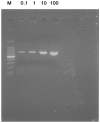Amplification of bacterial genomic DNA from all ascitic fluids with a highly sensitive polymerase chain reaction
- PMID: 29901148
- PMCID: PMC6072169
- DOI: 10.3892/mmr.2018.9159
Amplification of bacterial genomic DNA from all ascitic fluids with a highly sensitive polymerase chain reaction
Abstract
Due to varying positive rates of polymerase chain reaction (PCR) amplification, interpretation of conventional PCR results for non‑infectious ascites remains problematic. The present study developed a highly sensitive PCR protocol and investigated the positive rate of PCR for the 16S ribosomal (r)RNA gene in non‑infectious ascites. Following the design of a new PCR primer pair for the 16S rRNA gene (800F and 1400R), the sequences of PCR products were analyzed and the lower limit for bacterial DNA detection evaluated. The positive rate of PCR for 16S rRNA gene in non‑infectious ascites was also evaluated. PCR with the primer pair amplified the genomic DNA of 16S rRNA genes of major disease‑causing bacterial strains. Additionally, PCR with this primer pair provided highly sensitive detection of bacterial genomic DNA (lower limit, 0.1 pg of template DNA). When DNA samples isolated from ascites were used, the 16S rRNA gene was amplified independently of the presence of bacterial infection. PCR products contained the genomic DNA fragments of multiple bacterial species. Bacterial genomic DNA can be amplified from all ascitic fluids using a highly sensitive PCR protocol. Careful attention is required to interpret the results based on simple amplification of 16S rRNA gene with conventional PCR.
Figures







Similar articles
-
Real-time quantitative broad-range PCR assay for detection of the 16S rRNA gene followed by sequencing for species identification.J Clin Microbiol. 2006 Aug;44(8):2750-9. doi: 10.1128/JCM.00112-06. J Clin Microbiol. 2006. PMID: 16891488 Free PMC article.
-
[16S rRNA gene sequencing for pathogen identification from clinical specimens].Zhonghua Yi Xue Za Zhi. 2008 Jan 8;88(2):123-6. Zhonghua Yi Xue Za Zhi. 2008. PMID: 18353221 Chinese.
-
[Determination of ascitic bacterial 16S rRNA by quantitative PCR-microarray in the diagnosis of spontaneous bacterial peritonitis].Zhonghua Gan Zang Bing Za Zhi. 2011 Apr;19(4):297-300. doi: 10.3760/cma.j.issn.1007-3418.2011.04.015. Zhonghua Gan Zang Bing Za Zhi. 2011. PMID: 21586230 Chinese.
-
Establishment and analysis of specific DNA patterns in 16S-23S rRNA gene spacer regions for differentiating different bacteria.Chin Med J (Engl). 2003 Jan;116(1):129-33. Chin Med J (Engl). 2003. PMID: 12667405
-
[Bacterial DNA in patients with cirrhosis and sterile ascites. Its role as a marker of bacterial translocation and prognostic tool].Rev Esp Enferm Dig. 2007 Oct;99(10):599-603. doi: 10.4321/s1130-01082007001000007. Rev Esp Enferm Dig. 2007. PMID: 18052664 Review. Spanish.
Cited by
-
Guidelines on the management of ascites in cirrhosis.Gut. 2021 Jan;70(1):9-29. doi: 10.1136/gutjnl-2020-321790. Epub 2020 Oct 16. Gut. 2021. PMID: 33067334 Free PMC article.
-
Gut-Microbiota Dysbiosis in Stroke-Prone Spontaneously Hypertensive Rats with Diet-Induced Steatohepatitis.Int J Mol Sci. 2023 Feb 27;24(5):4603. doi: 10.3390/ijms24054603. Int J Mol Sci. 2023. PMID: 36902037 Free PMC article.
-
Clinical Evaluation of Metagenomic Next-Generation Sequencing Method for the Diagnosis of Suspected Ascitic Infection in Patients with Liver Cirrhosis in a Clinical Laboratory.Microbiol Spectr. 2023 Feb 14;11(1):e0294622. doi: 10.1128/spectrum.02946-22. Epub 2023 Jan 10. Microbiol Spectr. 2023. PMID: 36625589 Free PMC article.
-
Clinical evaluation of bacterial DNA using an improved droplet digital PCR for spontaneous bacterial peritonitis diagnosis.Front Cell Infect Microbiol. 2022 Aug 18;12:876495. doi: 10.3389/fcimb.2022.876495. eCollection 2022. Front Cell Infect Microbiol. 2022. PMID: 36061877 Free PMC article.
References
-
- Garcia-Tsao G, Lim JK. Members of Veterans Affairs Hepatitis C Resource Center Program: Management and treatment of patients with cirrhosis and portal hypertension: recommendations from the Department of Veterans Affairs Hepatitis C Resource Center Program and the National Hepatitis C Program. Am J Gastroenterol. 2009;104:1802–1829. doi: 10.1038/ajg.2009.360. - DOI - PubMed
-
- Enomoto H, Inoue S, Matsuhisa A, Aizawa N, Imanishi H, Saito M, Iwata Y, Tanaka H, Ikeda N, Sakai Y, et al. Development of a new in situ hybridization method for the detection of global bacterial DNA to provide early evidence of a bacterial infection in spontaneous bacterial peritonitis. J Hepatol. 2012;56:85–94. doi: 10.1016/j.jhep.2011.06.025. - DOI - PubMed
MeSH terms
Substances
LinkOut - more resources
Full Text Sources
Other Literature Sources
Medical
Research Materials

